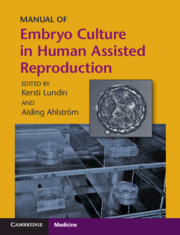Book contents
- Manual of Embryo Culture in Human Assisted Reproduction
- Cambridge Laboratory Manuals in Assisted Reproductive Technology
- Manual of Embryo Culture in Human Assisted Reproduction
- Copyright page
- Contents
- Contributors
- Preface
- Chapter 1 Facilities for Embryo Culture
- Chapter 2 Incubators for Embryo Culture
- Chapter 3 Consumables for the IVF Laboratory
- Chapter 4 Embryo Metabolism and What Does the Embryo Need?
- Chapter 5 Culture Media and Embryo Culture
- Chapter 6 Optimal Handling Techniques for Culture of Human Embryos
- Chapter 7 From Identification to Witnessing
- Chapter 8 Timing of Embryo Culture
- Chapter 9 Time-Lapse Technology
- Chapter 10 Laboratory Monitoring for Embryo Culture
- Chapter 11 Embryo Culture and IVF Offspring Outcome
- Chapter 12 The Changing Culture of Embryo Culture
- Index
- Plate Section (PDF Only)
- References
Chapter 3 - Consumables for the IVF Laboratory
Production and Validation, Quality Control, and Bioassays
Published online by Cambridge University Press: 15 April 2021
- Manual of Embryo Culture in Human Assisted Reproduction
- Cambridge Laboratory Manuals in Assisted Reproductive Technology
- Manual of Embryo Culture in Human Assisted Reproduction
- Copyright page
- Contents
- Contributors
- Preface
- Chapter 1 Facilities for Embryo Culture
- Chapter 2 Incubators for Embryo Culture
- Chapter 3 Consumables for the IVF Laboratory
- Chapter 4 Embryo Metabolism and What Does the Embryo Need?
- Chapter 5 Culture Media and Embryo Culture
- Chapter 6 Optimal Handling Techniques for Culture of Human Embryos
- Chapter 7 From Identification to Witnessing
- Chapter 8 Timing of Embryo Culture
- Chapter 9 Time-Lapse Technology
- Chapter 10 Laboratory Monitoring for Embryo Culture
- Chapter 11 Embryo Culture and IVF Offspring Outcome
- Chapter 12 The Changing Culture of Embryo Culture
- Index
- Plate Section (PDF Only)
- References
Summary
Since the birth of Louise Brown in 1978, IVF has evolved from a research-based environment to an established and regulated clinical treatment with around 2 million treatment cycles performed annually worldwide.
- Type
- Chapter
- Information
- Manual of Embryo Culture in Human Assisted Reproduction , pp. 20 - 29Publisher: Cambridge University PressPrint publication year: 2021

